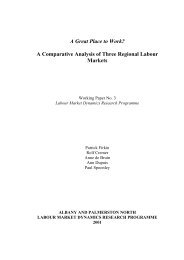The Law and Alternative Working Arrangements. - Labour Market ...
The Law and Alternative Working Arrangements. - Labour Market ...
The Law and Alternative Working Arrangements. - Labour Market ...
Create successful ePaper yourself
Turn your PDF publications into a flip-book with our unique Google optimized e-Paper software.
2. ALTERNATIVE WORKING ARRANGEMENTS2.1 Casual <strong>and</strong> Part-time Workers<strong>The</strong>re is no prescribed definition of a casual employee. However, the courts haveoften had to consider whether or not the nature of the employment is casual or parttime.This situation arises not in respect of the jurisdiction of the relevantemployment legislation (i.e. whether there is a contract of or for service) but inrespect of the termination of the employee. It is often assumed that by being classedas a casual worker, the employer can terminate the employment at will. This is whythe use of casual staff became an increasingly attractive option, particularly in theservice sector. However, simply by defining employment as casual does not exemptthe employer from the jurisdiction of employment legislation or requirements toterminate the employment fairly <strong>and</strong> in accordance with established common lawtests. 7In determining whether or not an employee is casual or part-time, the main criteria thecourts have considered are the permanency <strong>and</strong> continuity of employment. InCanterbury Hotel etc IUOW v Fell 1982 ACJ 285, the worker was employed as acasual bartender. <strong>The</strong> Court considered the concept of ‘casual worker.’ In this case,the definition of casual worker contained no provisions relating to dismissal on noticeor dismissal at all. This led to the proposition that she had been merely rostered off<strong>and</strong> therefore there was no dismissal. <strong>The</strong> court held that in their view, the workerwas really a part-timer. She worked on a regular basis, with set hours. <strong>The</strong>re wascontinuity of employment. Similarly in Barnes (formerly Kissel) v WhangereiReturned Services Association (Inc) [1997] ERNZ 626, the employee signed acontract which explicitly stated she was a casual employee being someone whoworked on an ‘as <strong>and</strong> when required basis’. After six months, she was rostered eachweek on regular days <strong>and</strong> hours. <strong>The</strong> Court held that the contract’s original terms hadbeen varied <strong>and</strong> that when this occurred, the contractual arrangements took on thefeatures of regularity <strong>and</strong> permanence.This case is significant because the nature of true casual employment often carrieswith it the notion that the employer does not have to offer work <strong>and</strong> the employeedoes not have to accept work. <strong>The</strong> Court discussed this. It found that on two of herrostered evenings, the worker was in sole charge of the bar <strong>and</strong> that this wasincompatible with a situation of true casual employment. <strong>The</strong> reason for this was thatif the worker had the freedom to accept or reject the offers of employment, then theemployer would have been in a state of total uncertainty about whether the bar wasgoing to be opened on the nights the worker was in sole charge.<strong>The</strong> rights of casual employees to the benefits that accrue as a result of being anemployee are no less than for any other employee. For example, given that s65 of theEmployment Relations Act 2000 requires all individual agreements to be in writing<strong>and</strong> to contain an explanation of the services available for the resolution ofemployment relationship problems, there can be no doubt that the procedures relating7 Refer to Tyson v Angus Inn Motor Hotel WET 706/92 4 June 1993 PR Stapp.9




